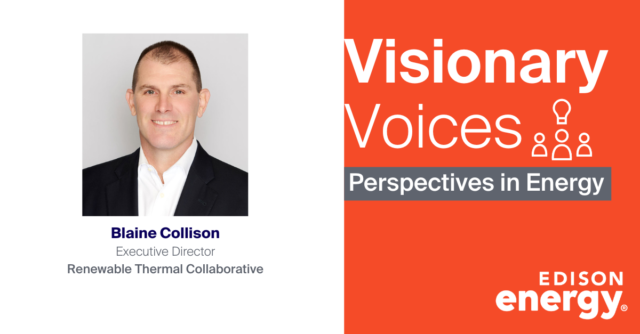
June 23, 2022
Large-scale thermal deployment will hinge on enabling policies and technologies like green hydro
By Elana Knopp, Senior Content Writer

In this last of a two-part series, Blaine Collison, Executive Director of the Renewable Thermal Collaborative (RTC), discusses plans to accelerate the deployment of renewable thermal solutions via several strategic levers, including key policies, technologies like green hydrogen and thermal storage, and replicable and scalable renewable thermal pilot projects.
Part II
The complexities of thermal
Companies aiming to decarbonize their Scope 1 emissions via renewable thermal energy must plan for a variety of considerations, including how much heat they need and at what temperatures, then take those technologies and deploy them at specific times and at different locations.
“There is complexity here,” Collison said. “For example, how do you integrate solar thermal into your operations? How does thermal storage fit in? What’s the role of efficiency? How do you think about and evaluate electrification opportunities, or combined heat and power? When does green hydrogen become a viable option? And how does a company optimize and plan for all of this? That’s part of the reason why companies like Edison are moving into this space–because you’ve been trusted partners. Companies need to be able to turn to somebody for help to develop a decarbonization strategy.”
Large energy users have consistently reported uncertainty around the current Scope 1 accounting and claims guidance in the World Resources Institute’s (WRI) Greenhouse Gas Protocol, according to the RTC. Many companies also report reluctance to advance decarbonization efforts without clear guidance in place for fear that projects they undertake now will ultimately be ruled ineligible.
Buyers have identified specific uncertainties around decarbonized fuels such as RNG (renewable natural gas) and green hydrogen, including eligibility and applicability of thermal instruments that are analogous to renewable energy credits (RECs) for electricity, as well as biogenic emissions tracking, according to the RTC.
Under the most recent guidance, biogenic CO2 emissions are tracked “out-of-scope,” or separately from CO2 fossil reporting. Knowing whether biogenic CO2 emissions will remain separate or become combined with CO2 fossil reporting will be critical for near-term decision-making.
Additionally, without standardized guidance on how to track biofuels over their complete lifecycle, buyers cannot be certain that biofuel purchases are actualizing emissions reductions.
Prioritizing policy
The RTC has convened a policy working group to draft a renewable thermal tax credit proposal, while also exploring whether pending legislation for an energy storage tax credit can be expanded to include thermal storage.
“The renewable electricity success arc has been borne of a constant cycle of amazing voluntary procurement and absolutely essential policies like the PTC, ITC, and RPS,” Collison said. “In some ways, RNG and green hydrogen remind us of where wind and solar were 25 years ago; they cost more than fossil-produced electricity, but they had the potential to scale and drive down costs. And thanks to policy support, voluntary buyers, and a lot of innovation, that’s what’s happened.”
The RTC believes that arc can be replicated with renewable thermal technologies like RNG, green hydrogen, solar thermal, thermal storage, and more.
“Green hydrogen is especially interesting as we think about expanding offshore wind and needing to store and move that energy that’s coming onshore around the clock,” Collison said. “Green hydrogen could be an incredibly compelling part of that solution.”
Over the next five years, the RTC plans to expand its initiatives to accelerate deployment of renewable thermal solutions through several strategic levers, including the creation of Technology Action Plans and Partnerships (TAPPs) around key renewable thermal technologies such as green hydrogen, thermal storage, renewable natural gas, solar thermal, and beneficial electrification.
There are also plans to pilot replicable and scalable renewable thermal energy deployment models through more than 35 new projects, then developing and disseminating the knowledge and case studies from these pilot projects.
“There’s a growing cohort of companies that has goals, and they’re not 2050 goals– some are 2028, which is about 10 minutes from now in the grand scheme of things,” Collison said. “To decarbonize Scope 1, a whole bunch of people in organizations are going to have to physically do an unbelievable amount of work. Companies have to find a pathway from their Scope 1 number into a forward looking, multi-year portfolio of real projects that make change. There’s a ton of economic activity to happen here, there’s a ton of change to make, there’s a lot of jobs to be had. And at the end of the day, we all get to breathe easier because the planet will stop heating up.”
Check out additional conversations with leading experts from across the industry in our Visionary Voices: Perspectives in Energy Series.
Join Our Mailing List
Supply Chain Decarbonization: Your Guide is Here!
Download our new white paper on establishing a successful decarbonization program.
Read More



